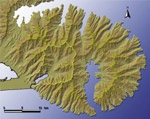Managing Te Roto o Wairewa: lessons from its past
Te Upoko o Tahumata te mauka Okana te awa Wairewa te roto Tahumata iss the mountain Okana is the river Wairewa is the lake

Te Roto o Wairewa (Lake Forsyth) is a shallow coastal lake on the southwest of Banks Peninsula. The lake is turbid due to high algal production and wind driven sediment resuspension. In summer it is prone to nuisance algal blooms, including toxic strains of cyanobacteria.
Traditionally, Te Wairewa and its catchment were regarded as the central food basket of Ngai Tahu in the Canterbury region. Extensive forests provided timber and fibre for building and weaving, as well as food and traditional medicines. Rivers, Wairewa itself, and the nearby ocean provided a bounty of food resources – fish, particularly tuna (eel), shellfish, marine mammals, and waterfowl. These resources are known to Ngai Tahu as mahinga kai, meaning literally ‘to work the food’. The term includes the traditional systems, processes, rules and regulations used to manage and protect the resources.
Since the European settlement of Wairewa, forest clearance, wetland drainage, pest and weed incursion, and the intensification of land use have had major effects on both terrestrial and aquatic environments. Wairewa Runanga has identified the rehabilitation of Wairewa and mahinga kai species as the priority environmental, cultural, spiritual, and economic issue within their area. The goal is to establish a Mahinga Kai Cultural Park (see www.ngaitahu.co.nz/tront-2025.html) in the area centred on the lake. A Mahinga Kai Cultural Park is an area of land and/or water managed for rehabilitating the environment, gathering traditional food, and supporting innovative economic initiatives that involve the use indigenous plants and animals.
Developing tools for rehabilitation
Rehabilitation of the lake and its catchment is fundamental to developing the cultural park and requires knowledge of past conditions. In Wairewa, the recent measured records of water quality and lake biota tell us little about conditions before the changes that occurred with European settlement of the region. However, a long record of conditions within the lake resides in the sediment that is deposited gradually and more or less continuously on the lakebed. The process of using sedimentary indicators to reconstruct lake history is known as palaeolimnology.
Reconstructing Te Wairewa history
A study by NIWA and the University of Canterbury is using sediments to reconstruct Wairewa’s history. Sediment cores show that the lake is over 7000 years old and that sedimentation rate is highly variable, ranging from a low 0.1 mm/year before the arrival of Europeans to 20 times that rate in the last 150 years. Results so far suggest that Te Wairewa has undergone substantial changes in its history. Salinity change is a feature of this history, with changes in sedimentation and the extent of submerged plant communities superimposed on this. The record highlights the complex interactions driving change in the lake and supports the emphasis of the proposed Mahinga Kai Cultural Park on whole catchment management.
Michael Reid [m.reid@niwa.co.nz] Robin Wybrow, Timana Wairewa Runanga Craig Woodward, Department of Geological Sciences, University of Canterbury
